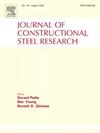Experimental and numerical study on seismic behaviors of corrugated plate shear walls
IF 4
2区 工程技术
Q1 CONSTRUCTION & BUILDING TECHNOLOGY
引用次数: 0
Abstract
The prefabricated corrugated steel plate shear wall is an innovative lateral-resistant and energy-dissipating component. This paper presents experimental and numerical investigations into seismic behaviors of the prefabricated corrugated steel plate shear walls. Firstly, two specimens with different plate thicknesses were tested under cyclic shear loads, exhibiting the typical global buckling failures and final fracture of the corrugated steel plates. The tested hysteresis loops exhibited a robust seismic performance and exceptional energy dissipation attributes, with peak viscous damping coefficients greater than 0.5. The peak loads were attained at drift angles of 1.35 % and 1.94 % for the two specimens. It can be seen that increasing the thickness significantly delayed the onset of buckling and enhanced the ductility. Subsequently, an additional numerical investigation into the behavior of prefabricated corrugated steel plate shear walls was carried out by employing a validated finite element model. The effects of the aspect ratio, horizontal and vertical corrugated layout, plate thickness, boundary elements, and compression load are involved in this study. The numerical results reveals that the structural behavior of corrugated steel plate is primarily determined by the length of the ridge line. The investigation reveals that when the aspect ratio surpasses 1.0, horizontal corrugated steel plate shear walls manifest a higher shear peak load in comparison to vertical corrugated steel plate shear walls. Moreover, it is noted that the axial compression load exerts a negligible influence on the shear-bearing capacity of the horizontal corrugated steel plate shear walls. In contrast, for vertical corrugated steel plate shear walls, the axial compression load results in an approximate 10 % decrement in shear-bearing capacity. Finally, some design recommendations are concluded to provide valuable references for the practical design of corrugated steel plate shear walls under cyclic horizontal shear loading.

求助全文
约1分钟内获得全文
求助全文
来源期刊

Journal of Constructional Steel Research
工程技术-工程:土木
CiteScore
7.90
自引率
19.50%
发文量
550
审稿时长
46 days
期刊介绍:
The Journal of Constructional Steel Research provides an international forum for the presentation and discussion of the latest developments in structural steel research and their applications. It is aimed not only at researchers but also at those likely to be most affected by research results, i.e. designers and fabricators. Original papers of a high standard dealing with all aspects of steel research including theoretical and experimental research on elements, assemblages, connection and material properties are considered for publication.
 求助内容:
求助内容: 应助结果提醒方式:
应助结果提醒方式:


